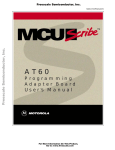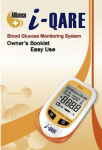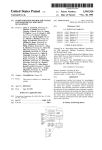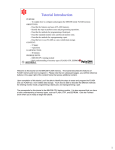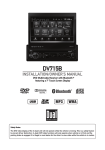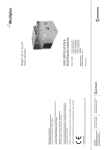Download User`s Manual
Transcript
XL36 Programming Adapter Board User's Manual How to Reach Us: Home Page: www.freescale.com E-mail: [email protected] Document Edition Date USA/Europe or Locations Not Listed: Freescale Semiconductor M68XL36PABUM/D Technical Information Center, CH370 1300 N. Alma School Road Chandler, Arizona 85224 +1-800-521-6274 or +1-480-768-2130 [email protected] April 1998 Europe, Middle East, and Africa: Freescale Halbleiter Deutschland GmbH Motorola reserves the right to make changes without further notice to any Technical Information Center products herein to improve reliability, function, or design. Motorola does not Schatzbogen 7 81829 Muenchen, Germany assume any liability arising out of the application or use of any product or circuit +44 1296 380 456 (English) described herein; neither does it convey any license under its patent rights nor +46 8 52200080 (English) the rights of others. Motorola products are not designed, intended, or +49 89 92103 559 (German) +33 1 69 35 48 48 (French) authorized for use as components in systems intended for surgical implant into [email protected] the body, or other applications intended to support or sustain life, or for any Information in this of document is provided product solely to enable system and software other application in which the failure the Motorola could create a Japan: to use Freescale Semiconductor products. There are no express or where personalimplementers injury or death may occur. Should Buyer purchase or Freescale Semiconductor Japansituation Ltd. implied copyright licenses granted hereunder to design or fabricate any integrated Headquarters circuits integrated circuits basedor onunauthorized the information in this document. use Motorola products for anyorsuch unintended application, ARCO Tower 15F Freescale Semiconductor reserves the right to make changes without further notice to Buyer shall indemnify and hold Motorola and its officers, employees, any products herein. Freescale Semiconductor makes no warranty, representation or 1-8-1, Shimo-Meguro, Meguro-ku, guarantee regarding the suitability of its products any particular purpose, nor does subsidiaries, affiliates, and distributors harmless against allforclaims, costs, Tokyo 153-0064 Freescale Semiconductor assume any liability arising out of the application or use of Japan damages, and expenses, and reasonable attorney fees arising out of, directly any product or circuit, and specifically disclaims any and all liability, including without 0120 191014 or +81 3 5437 9125 consequential or incidental damages. “Typical” parameters or indirectly, any claim oflimitation personal injury or death associated with such which may be [email protected] provided in Freescale Semiconductor data sheets and/or specifications can and do unintended or unauthorized use, even if such claim alleges that Motorola was vary in different applications and actual performance may vary over time. All operating Asia/Pacific: negligent regarding the design orincluding manufacture the part. for each customer application by parameters, “Typicals” of must be validated customer’s technical experts. Freescale Semiconductor does not convey any license Freescale Semiconductor Hong Kong Ltd. under its patent rights nor the rights of others. Freescale Semiconductor products are Technical Information Center Motorola, the Motorola logo, and MCUscribe are registered trademarks of intended for not designed, intended, or authorized for use as components in systems 2 Dai King Street surgical implant intoand the body, or other applications intended to support or sustain life, Motorola Inc. Windows, Windows NT, Windows 95 are trademarks of Tai Po Industrial Estate or for any other application in which the failure of the Freescale Semiconductor product Tai Po, N.T., Hong Kong Microsoft Corporation. Adobe and Acrobat Reader are trademarks of Adobe could create a situation where personal injury or death may occur. Should Buyer +800 2666 8080 purchase use Freescale Semiconductor products of for any such unintended or Systems Incorporated. All otherortrademarks are the property their respective [email protected] unauthorized application, Buyer shall indemnify and hold Freescale Semiconductor holders. and its officers, employees, subsidiaries, affiliates, and distributors harmless against all claims, costs, damages, and expenses, and reasonable attorney fees arising out of, For Literature Requests Only: or indirectly, any claim of personal injury or death associated with such Freescale Semiconductor Literature Distribution Motorola Inc.Center is an Equaldirectly Opportunity/Affirmative Action Employer. unintended or unauthorized use, even if such claim alleges that Freescale P.O. Box 5405 Semiconductor was negligent regarding the design or manufacture of the part. Denver, Colorado 80217 © 1998 by Motorola, Inc. All Rights Reserved. 1-800-441-2447 or 303-675-2140 Fax: 303-675-2150 [email protected] Motorola 6501 William Cannon Drive West Austin, Texas 78735 USA 2 User’s Manual for the M68PAL908XL36 Programming Adapter Board Contents 1 Getting Started Installing the MCUscribe application and personality files Installed files 6 6 Installing Acrobat Reader 7 Inserting XL36 programming adapter boards Inserting XL36 MCUs 7 8 Disconnecting power before inserting an MCU 8 Inserting a QFP MCU 9 Inserting an SDIP MCU 10 2 Using the XL36 Programming Adapter Board XL36 devices and mask sets 12 MCU memory configuration 13 908XL36 MCU memory 13 708XL36-secured MCU memory Adjusting the device supply voltage Restrictions and limitations 14 14 16 User’s Manual for the M68PAL908XL36 Programming Adapter Board 3 CONTENTS 3 Support Opening additional online documentation Contacting customer support 4 18 19 User’s Manual for the M68PAL908XL36 Programming Adapter Board 1 T Getting Started Who needs to read the XL36 Programming Adapter Board User’s Manual? Refer to the XL36 Programming Adapter Board User’s Manual if you have purchased an XL36 programming adapter board (PAB), and want information about: ■ Installing software and setting up the XL36 PAB for use ■ XL36-specific operation instructions ■ Getting additional support This chapter explains how to install the software that comes with your XL36 PAB, and how to plug in the XL36 PAB and the MCUs it supports. XL36 Programming Adapter Board User’s Manual 5 GETTING STARTED Installing the MCUscribe application and personality files The XL36 PAB comes with the latest version of the MCUscribe application (for Windows® NT and Windows 95). First, install the software: Insert the first MCUscribe diskette in your floppy drive, and enter a:\setup.exe in the Windows Run dialog box. The installation setup program opens. Follow the instructions to install the software in a folder of your choice. The installation program places all the MCUscribe files in one folder. Using a single folder expedites selection of the MCU and S-record files, so that you can start programming more quickly. Installed files These files are installed on your host system: ■ MCUscribe.exe — Windows executable file for the MCUscribe application—the interface you use to communicate with the SPGMR08, and to program MCU memory. ■ .mmp files — The personality files that supply the SPGMR08 with MCU configuration and memory map information. 908XL36.mmp and 708XL36.mmp are the personality files for XL36-supported MCUs. ■ MCUscribe.hlp and MCUscribe.cnt — Online help for using the MCUscribe application. ■ MCUscribe.pdf — Serial Programmer for HC08 User’s Manual. Instructions for using the MCUscribe application (help information in an Acrobat-format user’s manual). ■ QStart08.pdf — SPGMR08 QuickStart Guide. A streamlined guide (in Acrobat format) to setting up SPGMR08 hardware and software. ■ PABXL36.pdf — XL36 Programming Adapter Board User’s Manual. A short manual (in Acrobat format) that contains specfic instructions for setting up and using the XL36 PAB. The software may also include user manuals for other PABs. ■ readme.txt — Release notes in ASCII format (text from QStart08.pdf) For tips about opening online support documents, see page 18. 6 XL36 Programming Adapter Board User’s Manual GETTING STARTED Installing Acrobat Reader You must have Acrobat Reader™ installed on your host system in order to view and print the Serial Programmer for HC08 User’s Manual and other Acrobat-format support documents. The Reader is supplied on a separate set of diskettes. To install the Reader: Insert the first Reader diskette in your floppy drive, and enter a:\setup.exe in the Windows Run dialog box. The installation setup program opens. Follow the instructions to install the software in a folder of your choice. Inserting XL36 programming adapter boards To use the XL36 programming adapter board, plug the PAB onto the SPGMR08 base unit (as shown in the illustration below). The PAB works when installed in either direction on the SPGMR08 base unit. That is, the connector on the base unit labeled Pin 1 can accept either connector of the adapter board. QFP device socket case, with lid closed SDIP device socket 1 A ER L RO TO MO XL36 programming adapter board GE MM 1 T. LTA T RA VO DJUSROG 3 ST P A P TE L IA 08 C 68H SER M EMR STWE SY PO N PI ETR E CK W SO PO 1 A L RO O OT Pin 1 M + OR AT SPGMR08 base unit XL36 Programming Adapter Board User’s Manual 5V UL EM 7 GETTING STARTED Inserting XL36 MCUs Disconnecting power before inserting an MCU If power is disconnected, you can insert or remove MCUs freely. However, if you are in an MCUscribe session, make sure the yellow Socket Power light is off before you handle the MCU. MCUs can be damaged by power surges during installation. If the Socket Power light is on, click the Power Off button in the MCUscribe Control Panel. Socket power is disconnected, and the yellow Socket Power light goes off. 8 XL36 Programming Adapter Board User’s Manual GETTING STARTED Inserting a QFP MCU The illustration below shows a QFP MCU ready to be inserted in the PAB: 1 Open the socket case by lifting the latch on the left. 2 Insert the MCU, matching the MCU’s pin 1 with the socket’s pin 1. The marked corner of the MCU identifies the location of pin 1. If you turn the PAB so that the Motorola logo is at the bottom, pin 1 is in the socket’s upper left corner. (The printed number 1 on the back side of the programming adapter board corresponds to the location of the socket’s pin 1.) Note: Motorola recommends that you use a vacuum pen or other appropriate tool to handle MCUs. Be careful to avoid bending the pins. 3 Push the socket lid down gently until it snaps shut. Pin 1 is located at the MCU’s marked corner. (The marked corner has either a recessed dot or a clipped edge.) socket latch Pin 1 on the socket is in the upper left corner (when the PAB is viewed with the Motorola logo at the bottom). R ME RAM AL ERI 08 S C 68H G PRO EMR STWE SY PO M N PI ETR E CK W SO PO 1 A L RO TO O M GE T LTA VO DJUS A 3 1 T. TP TES A L RO O OT M + OR AT 5V UL EM XL36 Programming Adapter Board User’s Manual 9 GETTING STARTED Inserting an SDIP MCU The illustration below shows an SDIP MCU ready to be inserted in the PAB: Insert the MCU, matching the MCU’s pin 1 with the socket’s pin 1. The marked corner of the MCU identifies the location of pin 1. The printed number 1 shows the location of the socket’s pin 1. Note: Motorola recommends that you use a vacuum pen or other appropriate tool to handle MCUs. Be careful to avoid bending the pins. The MCU’s pin 1 is left of the half-moon depression. The pin 1 corner is also marked with a recessed dot on some devices. The socket’s pin 1 is identified by a 1 printed on the board. ER MM RA 08 C 68H M L RIA OG PR SE EMR STWE SY PO N PI 1 ETR E CK W SO PO 1 A OL OR OT GE LTA ST VO DJU A 3 1 PT. ST TE A L RO O OT M M + OR AT 5V UL EM 10 XL36 Programming Adapter Board User’s Manual 2 Using the XL36 Programming Adapter Board This chapter has specific information about using the M68PAL908XL36 (XL36) programming adapter board. The XL36 PAB enables the SPGMR08 to program: ■ Flash EEPROM memory ranges of MC68HC908XL36 (908XL36) microcontroller units (MCUs) in 64-pin Quad Flat Pack (QFP) or 56-pin Shrink DIP (SDIP) package configurations. ■ EPROM memory ranges of MC68HC708XL36 (708XL36) MCUs in 64-pin Quad Flat Pack (QFP) or 56-pin Shrink DIP (SDIP) package configurations. Note: If you need information about support for other XL36 MCU masks, contact Motorola customer support (see "Contacting customer support" on page 18). XL36 Programming Adapter Board User’s Manual 11 USING XL36 PROGRAMMING ADAPTER BOARDS XL36 Devices and Mask Sets Selected MCU / Mask choice Device Mask set Device supply voltage (VDD) Personality file MC68HC908XL36 2H68R 5V ( ± 10%) 908XL36.mmp 908XL36 2H17F 3V ( ± 10%) 708XL36.mmp 708XL36 H17F 3H17F 5V ( ± 10%) MC68HC708XL36 H68R The table above lists XL36-supported devices and mask sets, with these types of corresponding information: • Device supply voltage (VDD) — The voltage you can use for a particular device and mask set. For information about testing or changing this voltage, see "Adjusting the device supply voltage" on page 14. • Personality file — The files that supply configuration and memory map data for programming the various XL36-supported MCUs and mask sets. To program a particular mask set, the corresponding personality file for that mask set must be installed on the host system. • Selected MCU/Mask choice — The entry you select during an MCUscribe session, from the Control Panel’s Selected MCU list (shown in the illustration below). 12 XL36 Programming Adapter Board User’s Manual USING XL36 PROGRAMMING ADAPTER BOARDS MCU memory configuration 908XL36 MCU memory The 908XL36 MCU has 36 KB of programmable Flash EEPROM memory and 34 bytes of vector memory. MCUscribe’s Memory Map status box (shown below) displays the location of the Flash EEPROM memory arrays. XL36 Programming Adapter Board User’s Manual 13 USING XL36 PROGRAMMING ADAPTER BOARDS 708XL36-secured MCU memory The 708XL36 MCU has 36 KB of programmable EPROM memory and 34 bytes of vector memory. MCUscribe’s Memory Map status box (shown below) displays the location of the EPROM memory array. Adjusting the device supply voltage You can adjust the device supply voltage (VDD) of the XL36 programming adapter board to match the voltage in your target application. The XL36 programming adapter board can program MCUs at a range of voltages. To measure the current device supply voltage, use the test point (labelled E1): 1 Begin an MCUscribe session, and select the MCU. Note: To measure device supply voltage, you must first establish communcations between the software and the MCU. When the base unit’s yellow Socket Power light is on, communications are established. 2 Connect a voltmeter to pin 1 (VMCU) and pin 3 (GND—ground). Read the device supply voltage on the meter. 14 XL36 Programming Adapter Board User’s Manual USING XL36 PROGRAMMING ADAPTER BOARDS To change the device supply voltage, turn the screw on top of the voltmeter with a screwdriver. The variable resistor is in a blue case, with the words VOLTAGE ADJUST printed next to it. The test point is marked TEST PT, and printed numbers identify pin 1 and pin 3. adjustment screw Pin 1 (VMCU) Pin 3 (GND) E TAG ST L VO ERDJU MMA RA variable resistor 08 8HC L RIA SE M6 3 OG PR EMR STWE SY PO N PI 1 T. TP S TE ETR E CK W SO PO 1 A OL OR OT GE LTA ST VO DJU A 3 1 T. TP S TE A L RO O OT M M + R TO LA 5V U EM Note: For more information about voltage ranges appropriate for your device, see its General Release Specification. XL36 Programming Adapter Board User’s Manual 15 USING XL36 PROGRAMMING ADAPTER BOARDS Restrictions and limitations This restriction applies to the XL36 programming adapter board: 908XL36 PAB programming voltage: The 908XL36 PAB supports 3 to 5 volt programming; however, the currently available 908XL36 device functions only at 5 volts. 16 XL36 Programming Adapter Board User’s Manual 3 Support This chapter explains how to open information resources online, and how to contact customer support. Opening additional online documentation Acrobat-format documents The MCUscribe application comes with a user’s manual in Acrobat PDF format, along with the latest version of the Acrobat Reader. There are a number of online resources (described on page 6) that you can open from Windows Explorer by double-clicking the file name: ■ Serial Programmer for HC08 User’s Manual — MCUscribe.pdf (You can also double-click the manual icon in the MCUscribe program group.) ■ XL36 Programming Adapter Board User’s Manual (online version) — PABXL36.pdf ■ SPGMR08 QuickStart Guide — QStart08.pdf XL36 Programming Adapter Board User’s Manual 17 SUPPORT Online help Open MCUscribe help directly from the desktop, or from within the application. (Make sure you have installed the MCUscribe.hlp file and the MCUscribe.cnt files in the same folder.) You can use any of these methods to open MCUscribe help: • Double-click the help icon in the MCUscribe program group. • Double-click the MCUscribe.hlp file in Windows Explorer, if .hlp files are associated with Winhlp32.exe. • Click the Help button in the MCUscribe application, or press F1. Contacting customer support Contact the Motorola software support team by telephone, FAX, regular postal mail, or through the Worldwide Web. Telephone: 1-800-521-6274 (Customer Focus Center) Telephone support hours are Monday through Friday, 9:00 a.m. to 5:00 p.m. (CST). FAX: (602) 302-8157 (Customer Focus Center) Website: http://www.design-net.com/csic (68HC05 and 68HC08 8-bit Microcontroller Home Page) For software upgrades, choose Development Tools, then Free Software Upgrades/Assemblers. For more MCU products, see: http://www.mcu.motsps.com (Embedded Microcontroller Products page) Mailing address: 18 MCTG Software Support Motorola, Inc. MD OE45 6501 William Cannon Drive West Austin, Texas 78735 XL36 Programming Adapter Board User’s Manual


















